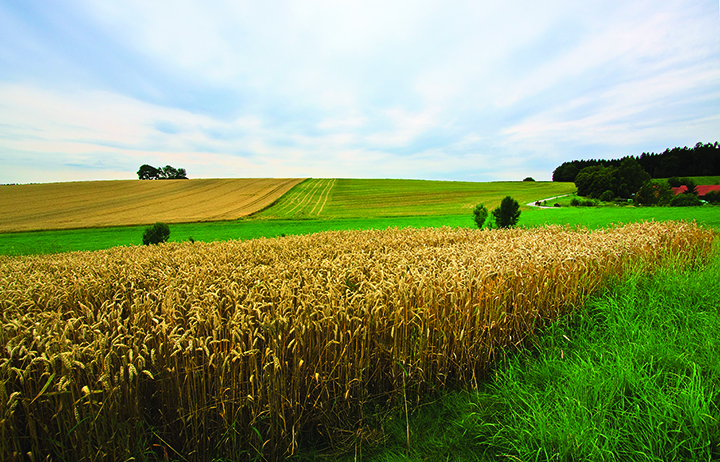The Daugherty Water for Food Institute – Feeding a Growing World

by Jesse Starita
Imagine watching a river basin as the winter ice melts and wildflowers stretch up from the ground, clouds rolling overhead like cotton balls dumped out of a giant bag in the sky, flowers blooming, weeds growing, seeds blowing in an autumn breeze, then snowflakes covering the dry grass as the year circles back—all within 60 seconds.
This is a glimpse of the Platte Basin Timelapse project, one of several research projects supported by the Robert B. Daugherty Water for Food Institute at the University of Nebraska (WFI). The project involves taking one photo an hour of areas up and down the Platte River Basin to develop a timelapse view of the land and weather. Using advanced software, researchers can quickly navigate the 1.5 terabyte image library, linking rich photographs to data from the U.S. Drought Monitor or USGS Water Data. Through this project, audiences can literally see man and nature’s impact on land and water.
The institute supports and shares this type of research to address the global challenge of achieving food security with limited water resources. In the next 35 years, the world’s population is expected to grow beyond 9 billion. Water shortages already occur in many of the world’s major food production areas and growing municipal and industrial demands are shifting water resources away from agriculture. At a time when agriculture must produce more food, water supplies are stretched to meet increasing demands and a changing global climate.
Founded in 2010, the Water for Food Institute spans all campuses of the University of Nebraska to maximize the university’s vast education, research and outreach expertise in agriculture, water management, food science and natural resources. Furthermore, the Nebraska Water Center, which has a long track record of engagement with the people of Nebraska, is now an integral part of WFI. Working together with other universities and public and private sector organizations—locally, regionally and across the globe—the institute is developing innovative solutions to produce more food using water more efficiently.
The Water for Food Institute bridges the worlds of large-scale and smallholder agriculture, concentrating on impact areas that are vital to water and food security both in Nebraska and globally:
- Yield and water productivity gaps, building on the pioneering work of the Global Yield Gap and Water Productivity Atlas, as well as the University’s expertise in plant breeding and biotechnology development to improve drought tolerance and crop water productivity.
- High-productivity irrigation, working, for example, to use remote sensing to monitor and predict yield and water productivity levels in real-time and implementing innovative projects in partnership with the private sector and social entrepreneurial groups in sub-Saharan Africa.
- Improving groundwater management, drawing on the vast experience of Nebraska’s water governance institutions and farmers, as well as the University’s technical and policy expertise in the subject to inform and guide policymakers, managers, producers and the public.
- Public health and ecosystems management, ensuring that efforts to improve water and food security also advance public health and protect ecosystem integrity, bringing to bear the University’s expertise in natural resources management, water quality analysis and technology, and public health.
Research is at the core of WFI programs, finding new ways to sustainably manage water and increase food security, inform policy and give students hands-on experience in the lab and field. Collaborative research programs are currently underway in Nebraska and agricultural areas of the U.S., India, Brazil, China, sub-Saharan Africa, the Middle East, North Africa and Latin America. These projects include sustainably increasing crop yields and water productivity using mapping, modeling and information systems; increasing the long-term productivity of crops and livestock in water-limited conditions; and improving drought management and climate change adaptation through monitoring, preparedness strategies and stronger warning systems.
More than 75 Faculty Fellows and dozens of post-doctoral, graduate and undergraduate students within the University of Nebraska system, as well as internationally, are contributing to WFI’s research, engagement and education programs.
In addition to supporting and promoting the Fellows’ water and food related research projects and sharing news and data with a variety of stakeholders, the institute hosts an annual Water for Food Global Conference. These conferences bring together thought leaders and experts from around the world to discuss strategies to address the challenge of doubling our agricultural production by 2050 and doing it with less water than we use today.
The most recent conference included more than 250 participants from 25 countries and focused on the role of data and information in transforming our agricultural yields and water management. Videos from many of the conference sessions and blog summaries of each day are available on the WFI website: waterforfood.nebraska.edu/wff2014/.
From research programs literally in the soil, to satellite moisture sensor technology in space, from policy development in community meetings, to knowledge shared through our Water for Food Global Conferences, the institute is producing results that matter—increasing food production with more effective and efficient use of water. Like millions of families around the globe, we want to put dinner on the table… for everyone.
You can learn more about the Water for Food Institute and join in the conversation about feeding our growing world through any of these online resources:
Follow @waterforfood on Twitter
Like us on Facebook
www.facebook.com/waterforfood
Find useful information on Pintrest
www.pintrest.com/waterforfood
Follow and submit comments on our blog
waterforfood.nebraska.edu/blog/category/blog/
Subscribe to our YouTube Channel
Youtube.com/waterforfood
Visit our website
Waterforfood.nebraska.edu













Recent Comments